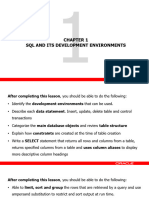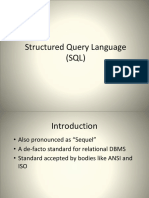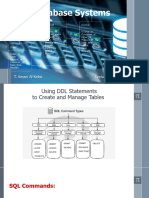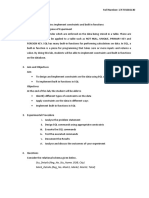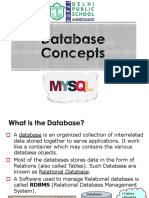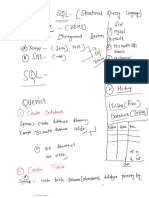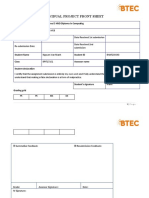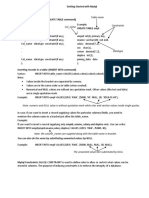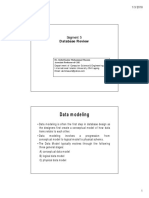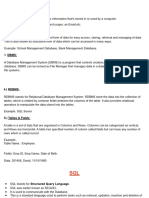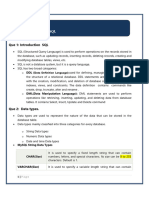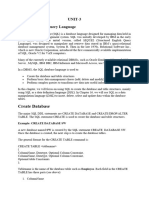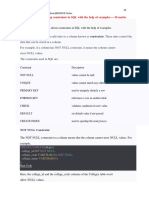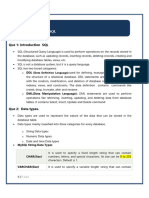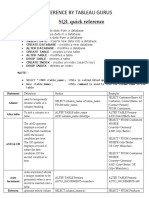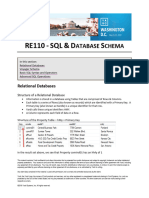DBMS - SQL 1
Uploaded by
shinjan280308DBMS - SQL 1
Uploaded by
shinjan280308SQL commands
To create a table in a Database Management System (DBMS) using SQL (Structured Query
Language), you use the CREATE TABLE command. This defines the table name and the
columns, along with their data types and optional constraints.
Basic Syntax:-
CREATE TABLE table_name (
column1 datatype constraint,
column2 datatype constraint,
...
);
Examples:
CREATE TABLE students (
student_id INT PRIMARY KEY,
name VARCHAR(30),
age INT,
dob DATE
);
Explanation:
• student_id is an integer and the primary key (unique identifier).
• name is a variable-length string of up to 100 characters.
• age is an integer.
• dob is a date field.
Fields/Attributes
student_id name age dob
1 Anuska 16 12/11/2008
Records/Tuples
2 Dekiba 17 13/12/2007
Creating a table named employees with the following fields-
1. Employee id – integer and primary key
2. Name – varchar (size=50) and not null
3. Email – varchar (size=50) and unique (cannot be duplicate)
4. Salary decimal (size=10, decimal value 2) and should be a positive number >0
5. Department_id - integer
6. Hire_date- date type and if no value given, the current system’s date will be added
CREATE TABLE employees (
emp_id INT PRIMARY KEY,
name VARCHAR(50) NOT NULL,
email VARCHAR(100) UNIQUE,
salary DECIMAL(10, 2) CHECK (salary > 0),
department_id INT,
hire_date DATE DEFAULT CURRENT_DATE
);
Types of Constraints in DBMS
Constraint Description
Uniquely identifies each record in a table. Must be unique and NOT
PRIMARY KEY
NULL.
Creates a relationship between two tables. References the primary
FOREIGN KEY
key of another table.
UNIQUE Ensures all values in a column are different.
NOT NULL Ensures a column cannot have a NULL value.
CHECK Ensures that values in a column meet a specific condition.
DEFAULT Provides a default value for a column when none is specified.
Summary of Key Constraints
Allows NULL? Allows Duplicates?
(It means you can have
Constraint Can Be Applied On
(It means you can multiple records with
leave this field the same value in this
empty) field)
PRIMARY KEY No No One column
UNIQUE Yes No One or more columns
NOT NULL No Yes One column
CHECK Yes Yes One or more columns
DEFAULT Yes Yes One column
FOREIGN KEY Yes Yes One or more columns
Practice problems:
Create a Books Table
Requirements:
• book_id (Primary Key, Integer)
• title (VARCHAR, not null)
• author (VARCHAR, not null)
• price (DECIMAL, must be > 0)
• published_year (INTEGER)
Create a Students Table
Requirements:
• student_id (Primary Key)
• name (cannot be NULL)
• email (must be unique)
• dob (date of birth)
• enrollment_date (defaults to current date)
Inserting data into the table in a database
General syntax:
INSERT INTO table_name (column1, column2, ...)
VALUES (value1, value2, ...);
Or
INSERT INTO table_name (column1, column2, ...)
VALUES
(value1a, value2a, ...),
(value1b, value2b, ...);
Examples
INSERT INTO students (student_id, name, email, dob)
VALUES (1, 'Alice Johnson', '[email protected]', '2003-04-15');
INSERT INTO students (student_id, name, email, dob)
VALUES (2, 'Bob Smith', '[email protected]', '2002-09-30');
Or
INSERT INTO students (student_id, name, email, dob)
VALUES
(1, 'Alice Johnson', '[email protected]', '2003-04-15'),
(2, 'Bob Smith', '[email protected]', '2002-09-30');
You might also like
- Top 58 MySql Interview Questions (2023) - JavatpointNo ratings yetTop 58 MySql Interview Questions (2023) - Javatpoint37 pages
- Tutorial 3 Chapter 03 The Relational Database Model QuestionNo ratings yetTutorial 3 Chapter 03 The Relational Database Model Question6 pages
- Dbms Mid-1 Unit-2 Longs Questions With AnswersNo ratings yetDbms Mid-1 Unit-2 Longs Questions With Answers25 pages
- Structured Query Language (SQL) : What Is SQL? SQLNo ratings yetStructured Query Language (SQL) : What Is SQL? SQL32 pages
- Master Note For Streams Recommended ConfigurationNo ratings yetMaster Note For Streams Recommended Configuration71 pages
- Individual Project Front Sheet: Qualification BTEC Level 5 HND Diploma in Computing Unit Number and Title Submission DateNo ratings yetIndividual Project Front Sheet: Qualification BTEC Level 5 HND Diploma in Computing Unit Number and Title Submission Date12 pages
- You Can Also Do The Same by Substituting Unwanted Values by NULLNo ratings yetYou Can Also Do The Same by Substituting Unwanted Values by NULL2 pages
- Paint Shop Management System Project ReportNo ratings yetPaint Shop Management System Project Report61 pages
- LAB 02 Data Types. Create and Alter Table Structure: V Main ContentsNo ratings yetLAB 02 Data Types. Create and Alter Table Structure: V Main Contents12 pages
- The REA Approach To Business Process ModelingNo ratings yetThe REA Approach To Business Process Modeling34 pages
- HRMS DocumentationHRMS DocumentationHRMS DocumentationNo ratings yetHRMS DocumentationHRMS DocumentationHRMS Documentation82 pages
- Cassandra Query Language by Examples - Puzzles with AnswersFrom EverandCassandra Query Language by Examples - Puzzles with AnswersNo ratings yet









